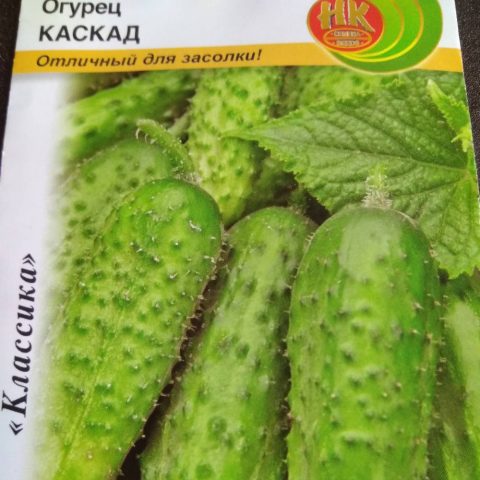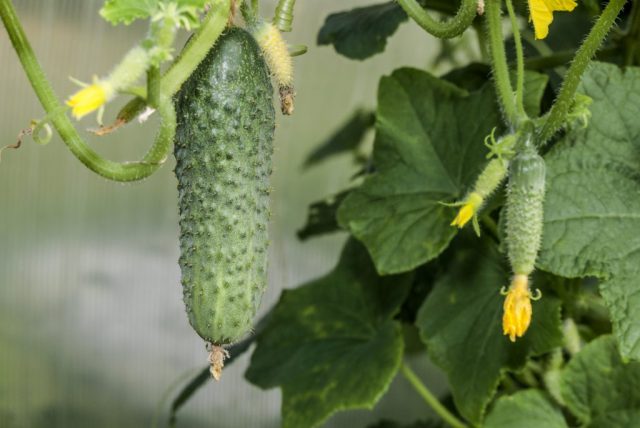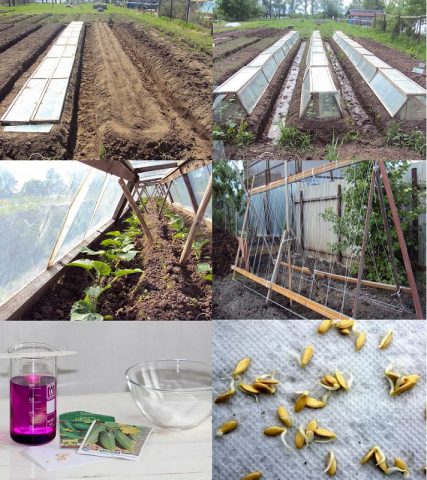Content
Cucumber Cascade is one of the "oldest", but still popular varieties of cucumber culture of the pumpkin family. The appearance of the Kaskad cucumber variety at the end of 1977 was preceded by painstaking selection work by employees of the Far Eastern Research Institute of Agriculture and Plant Growing. Only 5 years later, the cucumber Cascade was included in the State Register of Approved Plants with accreditation in the Far East region.
Description of the variety of cucumbers Cascade
For the cucumber variety Cascade, the formation of stems (lashes) of an average length of up to 1.5 m is characteristic, with the presence of obligatory pubescence. This factor is genetically embedded in cucumbers and has a protective function. Along the entire length of the stem, nodes are evenly located, from which leaf plates, lateral shoots, flowers or antennae subsequently emerge. The formation of side lashes in the Cascade cucumber is of an average character, which allows us to say about the average level of climbing of this variety.
The leaf plate has a rich green color with an emerald tint, and the shape is closer to rounded, with five-blade pointed ends. The upper and lower surfaces have soft pubescent spines, and wrinkled grooves are clearly visible on the leaf surface. The largest leaf plate can be from 12 to 18 cm in diameter.
The root system of cucumbers Cascade has good branching, but at the same time it does not go deep into the soil. This indicates a weak development of root processes, as a result of which they develop closer to the soil surface, not exceeding 30 cm in depth.
Peduncles of cucumbers Cascade are determined by the presence of both male and female flowers, with a predominance of the latter.
Detailed description of the fruits
Description of the variety of cucumbers Cascade will not be complete without a detailed description of the fruits themselves. In shape, they resemble an elongated ellipse with pronounced tubercles, small in size, with the presence of miniature black spines. For the Cascade cucumber variety, a characteristic feature is the evenness of the fruit without the appearance of hooks.
The fruits of the Cascade cucumbers are colored green. Sometimes the appearance of longitudinal stripes of milky green color is possible. The fruits of the Cascade variety belong to the gherkin type cucumbers, due to the size:
- length - no more than 14 cm;
- diameter (cross section) - no more than 4.5 cm.
Weight indicators of one cascade cucumber can vary from 90 to 120 g, which depends only on the growing conditions and plant care.
Description of the variety of cucumbers Cascade must be continued with its taste characteristics and, importantly, the area of application of ripe products.
The cucumbers taste rather tender and crunchy, without bitterness. The use of fruits is universal:
- fresh;
- in salting;
- in canned;
- frozen.
Due to its dense and elastic structure, ripe fruits have the ability to long-term storage without the appearance of yellowness. This fact allows not only to store for a long time, but also to transport finished products without losses.
The main characteristics of the variety
Since the Kaskad cucumber variety is zoned in the Far Eastern region, it is safe to say that these cucumbers are quite hardy and tolerate short-term temperature drops perfectly. But, when choosing a place for planting, you should give preference to a site that is less prone to drafts.
For watering, the cucumber Cascade is quite demanding, which does not allow us to speak of its increased drought resistance.
One of the characteristic features of this variety is the versatility of planting. Despite the fact that the Cascade cucumber is a cultivar, not a hybrid, and belongs to bee-pollinated cultivars, it can be grown both outdoors and indoors.
Yield
It takes 45 days from sowing Cascade cucumber seeds to harvesting, which corresponds to the category of early ripening varieties, with a friendly return of the harvest. Judging from the photos and reviews of gardeners, Cascade cucumbers are able to please with the number of ripe fruits - up to 4 kg of cucumbers can be harvested from one plant.
When determining the yield from 1 sq. m, it is worth considering the growing method:
- When grown in spread, the yield will be 16 kg.
- When grown on trellises - 12 kg.
The methods of planting and methods of growing Cascade cucumbers will be discussed further.
Pest and disease resistance
The Cascade cucumber variety has an increased immunity to downy mildew, but to the rest of the diseases, to which cucumber crops are most often susceptible, the resistance is above average. When the first signs of disease appear, treatment with fungicidal preparations should be carried out:
- Bordeaux mixture;
- preicur;
- preicur energy;
- allett.
Cucumber Cascade is not highly immune to attacks of insect pests such as aphids and whiteflies. But to get rid of them for gardeners will help preparations of insecticidal and acaricidal action:
- Aktara;
- Decis Profi;
- Fitoverm;
- Biotlin.
Pros and cons of the variety
Cucumbers Cascade, like any other crops, have positive and negative qualities, which are worth talking about in more detail.
The main advantages of this variety include:
- Early ripeness.
- Amicable ripening.
- Gherkin type of zelents.
- Lack of bitterness and yellowness.
- The versatility of using ripe fruits.
- Transportability.
- Resistant to downy mildew.
Reading the reviews of gardeners, we can conclude that, as such, Cascade cucumbers have no shortcomings. Most lovers of summer cottage farming consider it a minus precisely the fact that the cucumber does not belong to self-pollinated varieties. But even despite this, the popularity of the variety has not faded for a long time.
Growing rules
For cucumbers of the Cascade variety, several growing methods are suitable:
- Seedling.
- Seedless.
When choosing a seedling method, you should be very careful when transplanting ready-made seedlings into open ground or a greenhouse. The root system of cucumbers is very delicate and can be injured during transplantation. This, in turn, can lead to the death of a young seedling.
Sowing dates
If the gardener decides to grow seedlings, then planting cascade cucumber seeds should be started in late March or early April. To plant seeds in open ground or a greenhouse, you should wait until warm weather is established and there is no threat of spring frosts. The best time for planting seeds will be the second half of May.
Site selection and preparation of beds
As already mentioned, for planting cucumbers in the open field, you must choose an area that is not subject to drafts. But these are not all the conditions that must be met before planting cucumber seeds or seedlings.
The best solution would be to choose an open area where they grew up last season:
- beans;
- peas;
- beans;
- potatoes;
- radish;
- beet;
- bow;
- garlic.
If cucumbers will grow in a greenhouse, then they need to be planted where tomatoes and bell peppers grew last year.
If the crop rotation was carried out correctly, then the Cascade cucumber will delight the gardener with a bountiful harvest.
The soil of open and greenhouse soil must be prepared in the fall. This requires:
- Dig up the soil to the depth of the shovel bayonet.
- Remove weeds and fallen leaves.
- Plant siderat herbs - mustard, oil radish, phacelia.
With the arrival of spring, the soil will need to be dug again together with the ascended green manure, which will enrich the soil with useful substances.
A good solution for open ground would be to prepare "warm beds" in which the Cascade cucumbers will feel much better.
Rules for the preparation of high "warm beds":
- You need to dig a trench 25 cm deep.
- At the bottom of the trench, you need to lay branches, needles or sawdust.
- Cover up the "natural drainage" with earth.
- Spill well with water.
- At this stage, you need to add fertile soil, consisting of earth, humus and sand. All components are taken in equal proportions and mixed.
- Potash-phosphorus fertilizers are applied - per 1 m2 you will need 8 tbsp. l. wood ash and 3 tbsp. l. superphosphate.
The soil or the beds are ready, now you can start the planting itself.
How to plant correctly
When planning the planting of seeds or seedlings of cucumbers of the Cascade variety, it is necessary to take into account the growing method:
- When grown in spreading, planting is carried out only in open ground with a planting density of 4 plants per 1 m2.
- It is possible to grow cucumbers by vertical production on stakes or trellises in greenhouses and in open ground with a planting density of 3 plants per 1 m2.
Embedding seeds in the soil should not exceed 2 cm in depth, and when planting seedlings, the most important thing is not to damage the root.
Cucumber seedlings should be planted by transferring them from a pot into a pre-prepared hole up to 5 cm in diameter. Having carefully placed a seedling in it, the root must be sprinkled with earth and shed well.
Follow-up care for cucumbers
In the future, caring for the Cascade cucumbers will consist in timely watering, loosening and feeding.
Cucumber Cascade is quite picky about watering, it is this feature that should force the gardener to provide the plants with the required amount of moisture - up to 5 liters of water for each root with an interval of 4 days. After watering, it is necessary to loosen the soil with the simultaneous removal of weeds.
There are no special rules for forming a bush. But a greater amount of yield can be achieved by growing the Cascade cucumber in one trunk, with the removal of side shoots.
Until the beginning of flowering, Cascade cucumbers will need complex fertilizers - NPK 20:20:20. During the flowering period, it is necessary to feed with less nitrogen.
Conclusion
As can be seen from the description, the Cascade cucumber is quite unpretentious in care, but most importantly, it is able to endow gardeners with a friendly and early harvest of tasty and juicy fruits. By collecting cucumbers once every 3 days, you can subsequently prepare a large number of your favorite dishes that you can enjoy throughout the winter.
Testimonials













